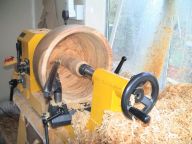nev
Established Member
:wink:
Just attempting my first BIG bowl , 17 x 3 :shock: in sapele. mounted on a faceplate and a bit of ply with plenty of two inch screws, I have turned the underside curved edge and am about to attack the bottom and chucking/ mounting method, but i am unsure as to the safest way to mount it when i turn it around to do the inside.
normally (6-8 inch bowls) it would be a 50mm dovetailed recess, mount in chuck (xt450) and away we go, but i doubt that would hold a bowl of this size.
How do I proceed safely? what mounting method can I use?
suggestions please (hammer)
Just attempting my first BIG bowl , 17 x 3 :shock: in sapele. mounted on a faceplate and a bit of ply with plenty of two inch screws, I have turned the underside curved edge and am about to attack the bottom and chucking/ mounting method, but i am unsure as to the safest way to mount it when i turn it around to do the inside.
normally (6-8 inch bowls) it would be a 50mm dovetailed recess, mount in chuck (xt450) and away we go, but i doubt that would hold a bowl of this size.
How do I proceed safely? what mounting method can I use?
suggestions please (hammer)

































